ऑयल पाम नर्सरी को संक्रमित करने वाली बालवाली इल्ली, डासचिरा मेंडोसा हबनर
Oil palm, Elaeis guineensis Jacq is the richest source for vegetable oil production with a capacity of 4-6 tons of oil per ha per year. The productivity of the palm is affected by at least 80 species of arthropods that are potential pests on oil palms.
There are many insect pests viz., bagworm, leaf webworm, hairy caterpillars, grasshoppers, flea beetles, ash weevils, termites, rodents, wild boar etc. which damage the oil palm nursery and affect their normal growth and development.
Superior planting material is one of the basic factors affecting the success of an oil palm plantation. Good nursery management would be required to ensure the production of good and healthy seedlings from a nursery in order to achieve early bearing and high yields in the field.
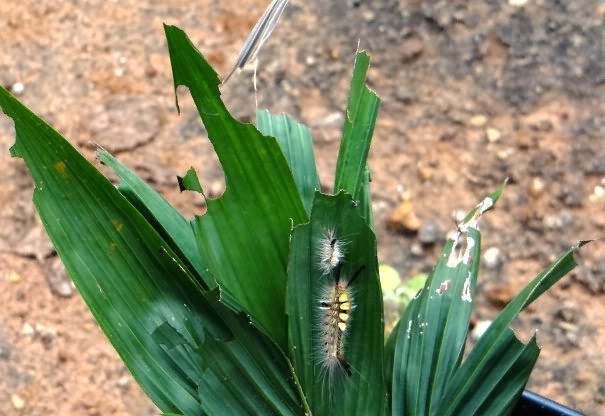
Damage to oil palm nursery leaves
Pest management practices in oil palm nursery is essential in order to get better palms. Hence, for better pest management practices, a good knowledge of biology, nature of damage, seasonal occurrence, association of natural enemies etc. are of prime importance.
In this article, it is discussed about tussock caterpillar, Dasychira mendosa a potential insect pest defoliating nursery and cause stunting symptom.
Distribution and host range
Tussock caterpillar, Dasychira mendosa Hubner (Lepidoptera: Lymantriidae) is a polyphagous pest widely distributed in India and reported to feed on wild and cultivated plants. It is found in India, Bangladesh, Sri Lanka, Indonesia, Taiwan, Thailand and Australia.
Caterpillars of D. mendosa feed on leaves of tea, mango, castor, cotton, pigeon pea, citrus, sorghum, sun hemp, maize, ber, sapota, brinjal, coffee, sunflower, Acacia nilotica, Cedrus deodara, cinnamon, cauliflower, potato, Flemingia semialata, teak, arecanut, cocoa and many other plant species. It is also found defoliating oil palm nursery leaves.
Life history and nature of damage
The adult is smoky brown with hind wings that are pale gray in colour. Fore wings are uniformly brown, with black specks and a pale patch outside the sub basal line. Females are bigger in size with filiform antennae, while males are smaller with pectinate type of antennae.
Gravid female lays eggs in masses mostly on the under surface of the nursery leaves of oil palm. On an average, each female lays about 302.9±39.9 eggs under confinement on blotting paper (as substrate for egg laying).
The freshly laid eggs are more or less spherical in shape, creamy white in colour. They later change to brown and blackish in colour just before hatching. The eggs normally hatch in 5.5±0.2 days. Soon after hatching, the neonate larvae damage the leaves by scrapping the lower surface of the leaves in groups, leaving epidermis intact.
Older larvae (4th instar onwards) defoliate the leaves vigourously and irregularly leaving with main veins intact. A group of tussock moth caterpillars could defoliate a whole plant overnight. Surface of the leaves grazed by young larvae is littered with black small frass. Frass is present on soil under defoliated plants.
The fully grown caterpillar is yellowish to grayish with red stripes on the prothorax and paired lateral tufts of grayish white hair on each segment of the body. A pair of brownish hairy long tufts project anteriorly over the head. On the last abdominal segment, on tail like brownish hairy tuft is present. The larva pass through 7 to 10 instars in about 43.1± 2.8 days (ranging from 39.0 to 50.0 days) and reach pupal stage.
Generally, 10.0 per cent of the larva pass through 7 instars, 40.0 per cent passed through 8 instars, 30.0 per cent passed through 9 instars and 20.0 per cent larvae passed through 10 instars before reaching pupal stage. The last instar larvae attaches itself to the leaves or come down to the bottom of the plant, stops feeding and start spinning silken cocoon, enters in a quiescent stage to convert itself into pre-pupal stage which lasts for 1-2 days.
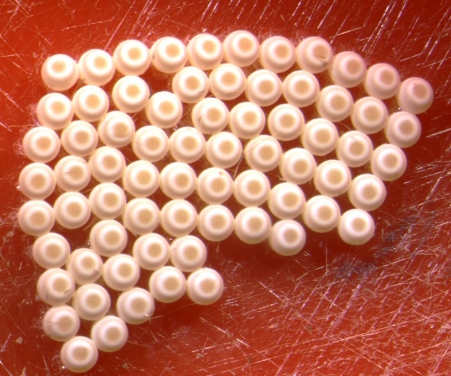
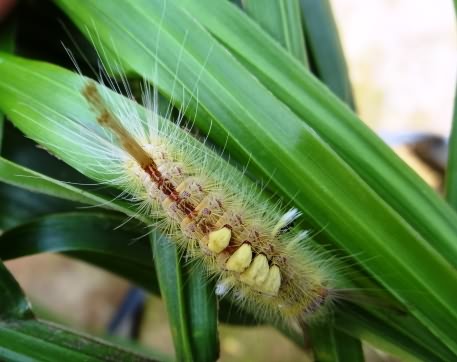
Eggs of tussock caterpillar Larvae of tussock caterpillar
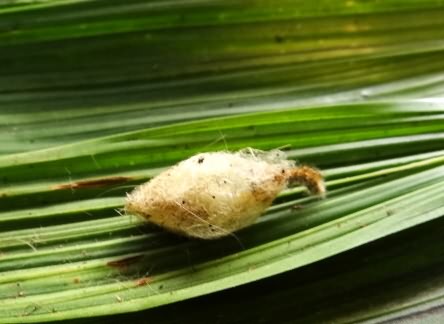
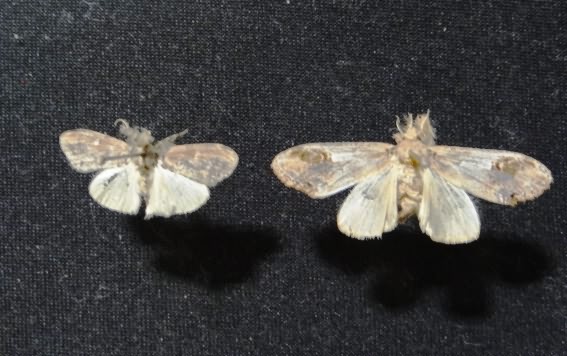
Pupal cocoon of tussock caterpillar Adults (male and female) of tussock caterpillar
The size of the caterpillars got reduced in size and transformed into pupa leaving the exuviae. The pupation takes place in loose dirty brown silken cocoons interwoven with larval body hairs .
The pupae are obtect and brown in colour. Adults emerge out of pupae in about 6.2±0.2 days. The longevity of male and female are about 8.4±0.7 and 9.6±0.2 days respectively.
An average total life cycle is (from egg to adult) 65.1±3.6 days. There is a possibility of difference in developmental period in each life stage on different crops due to nutritional status, chemical composition and physical properties of different hosts, as they play a significant role in insect development.
Seasonal occurrence
The pest appears in the oil palm nursery at the onset of South west monsoon i.e. June- July and remain active up to first fortnight of November. Normally it is not observed in other months in Andhra Pradesh conditions although its incidence is noticed throughout the year in oil palm nursery in Kerala conditions. This is difference is due to climatic conditions of different locations.
Natural enemies
A tachinid fly (Diptera: Tachinidae) is found parasitizing the larvae of D. mendosa. The fly injects egg into the caterpillar. Upon hatching, the fly maggots burrow inside the host and feed from inside the body. The affected caterpillar become sluggish reduce in size and fail to pupate and eventually die. The mean parasitism is normally about 10.2 per cent during the pest activity period.
In addition, the pupae of D.mendosa is parasitized by Brachymeria albotibialis (Ashmead) (Hymenoptera: Chalcididae). The parasitized pupa turn to dark brown or black in colour.
Only one parasitoid individual emerges out per host pupa. Once the parasitoid emerged out, the empty pupal case is remained with circular hole at the head region. The level of parasitism at field conditions is normally recorded as 40.0 per cent.
These information on biology, nature of damage, seasonal activity and natural enemies of D. mendosa could be used for planning and developing effective pest management strategies in oil palm nursery.
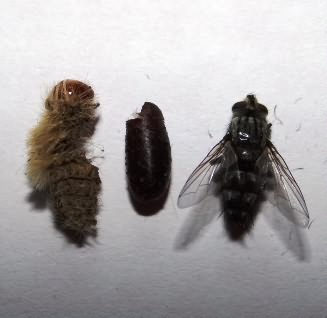

Parasitoid (Tachnid fly) larvae Parasitoid (Brachymeria albotibialis) pupa
Authors:
L.SARAVANAN* AND T. PHANIKUMAR
ICAR-Indian Institute of Oil Palm Research, Pedavegi-534 450, West Godavari (Dt.), Andhra Pradesh.
*Present address: Entomology Section, ICAR-Sugarcane Breeding Institute, Coimbatore-641007, Tamil Nadu.
Email:
